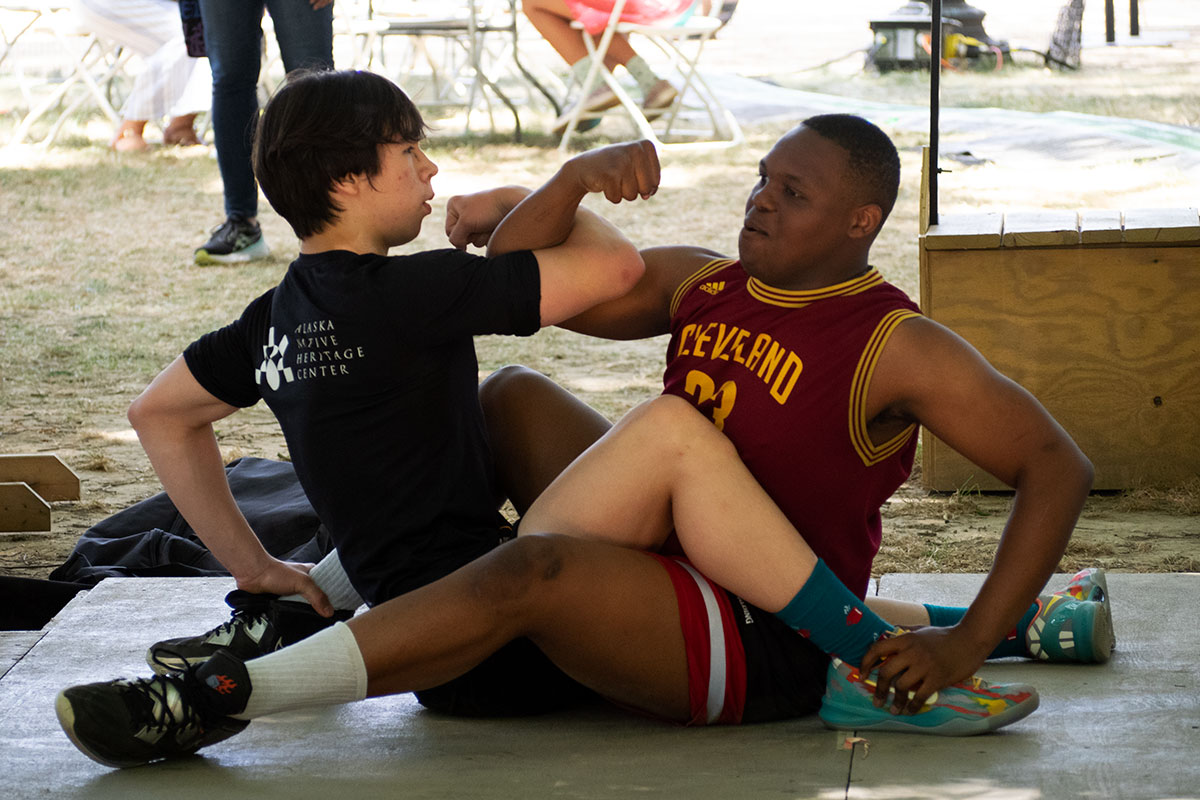Prayer in Movement: Arctic Games with Pamyua and Friends

Peter Pilak Griggs and London Walker face off in an arm pull demonstration at the 2024 Smithsonian Folklife Festival.
Photo by Craig Fergus, Ralph Rinzler Folklife Archives
“The games are like a prayer.”
—Phillip Blanchett
The anticipation and uproar on the National Mall was palpable watching Peter Griggs execute a strong two-foot-high kick. This kick requires the athlete to jump and kick, with both feet, a hanging target, then they must land on two feet and maintain perfect balance.
Two-foot-high kicks were among the many tradition-based Inuit games demonstrated at the 2024 Smithsonian Folklife Festival by “Pamyua and Friends”: Phillip Blanchett (Yup’ik), Peter Pilak Griggs (Yup’ik/Sugpiaq), and London Walker.
As an intern stationed at the Festival’s Sports & Games Pavilion, I watched every Arctic games presentation from the sidelines in awe of the pure athleticism, strength, and endurance that shines through. In further conversation with Blanchett and Griggs, I gained a deeper understanding of the cultural, fundamental roots of the games and the importance of mentorship as a means of connecting deeper with self, community, and the games themselves.
Among many accolades, Blanchett is well known for founding the band Pamyua with his brother, Qacung Blanchett. Pamyua honors and shares Indigenous culture through music and dance performances highlighting a fusion of Inuit drum rhythms and R&B vocal styling. At the Festival, members of Pamyua performed with other traditional dancers and athletes. Among them was Griggs, a young Alaska Native who has worked at the Alaska Native Heritage Center in multiple roles, including as the Native Youth Olympic coach and the current communications and development coordinator.


On the surface, a demonstration of Arctic games events could seem like solely a physical feat of strength and agility. To do the seal hop, athletes travel a set distance by hopping on their knuckles and toes in a lowered push-up position, maintaining strong form and balance. For the one-arm reach, athletes balance their whole bodies on one hand while swiftly reaching up with the other to hit a hanging target. Evidently, there is physicality, hard work, and training needed to break an Arctic games world record—which Blanchett and Griggs have both done!
However, the games are more than just the product of hours spent in the gym. The fundamental values of the games are deeply rooted in Inuit culture and provide “a real special way that Indigenous cultures are able to celebrate excellence and happiness,” Blanchett described.
Delving into the heart of the games, Griggs highlighted the fundamental value: respect. As he explained, “[the games] started in respect for the land, respect for the animals, respect for everything that helps us sustain our life”—including elders and ancestors.
“I always like to explain that the games are like a prayer,” Blanchett said. “They’re no different [from] how our dances are prayers as well. Just like we are taught that we naturally have reverence to the way people pray, I really want our athletes to understand that there’s a reverence in the games that we do and that they are no different from other prayers.”

Like many Indigenous athletes, both Griggs and Blanchett’s experience and connection to the games transcend beyond the physical realm. To them, the games offer space to find strength in community and mentorship. Mentorship rooted in cultural context and values can be a powerful tool to inspire participation in the games.
Griggs described Blanchett as “one of the biggest cultural inspirations and mentors in my life.” In working together at the Festival, they connected around the values of the games, which they both observed can be overshadowed by a shift toward competitiveness.
“We both are really interested in that tradition of friendship and sticking to the roots,” Griggs said. “If you don’t do the games with that in your mind and in your heart, then you’re going to be completely disconnected to the reason that we have been doing them and the reason we still do them.”
Mentorship inspires Blanchett to find strength and inspiration in the games, ultimately deepening his cultural connection. “I’m just really honored to carry on the confidence that I got from my mentors, Big Bob and Brian [Randazzo], and Ben Snowball. That’s what I gained from them—a confidence that it was something beyond me. It was something outside of myself but that I was connected to.”

Learning from elders can inspire confidence and deepen cultural connection, but it doesn’t mean always doing things exactly the same way your forebears did. Blanchett explained mentorship as a crucial force in allowing him to feel comfortable in having space to honor the creativity of the younger generation.
“Then there’s a better chance that it’s not going to just turn into a Westernized game or just die off,” he said. “It’s going to stay. It’s still going to have a form that you respect, but then there’s also going to be an openness that honors the possibilities.”
As Blanchett described his hopes for the future of Arctic games, he said that it’s important for audiences to consider what they can do to uplift, honor, and respect Indigenous voices and traditions. Increasing cultural awareness, Griggs agreed, is crucial.
“People still think we live in igloos and all this stuff,” he said. “So making sure that everyone has a proper and respectful education is one of my biggest things.”
The Arctic games are more than just games. They provide an opportunity to spark deeper cultural learning and understanding of the transmission of tradition.

Sophia Fedus is a program intern for the Indigenous Voices of the Americas program at the 2024 Smithsonian Folklife Festival and a recent graduate of Brandeis University, where she studied anthropology and creativity, the arts, and social transformation.

